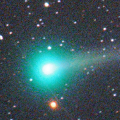
|
It brightened up to 5.6 mag in early December (Dec. 9, Marco Goiato). In mid December, it was visible at about 3 mag in the SOHO spacecraft images (Dec. 18, Hirohisa Sato). Now it is not observable. It will appear in the morning sky again in April. But then it will be fainter than 15 mag.
Date(TT) R.A. (2000) Decl. Delta r Elong. m1 Best Time(A, h)
Dec. 26 18 13.96 -18 6.5 1.503 0.532 5 7.1 5:35 (282,-14)
Jan. 2 19 0.09 -15 20.1 1.617 0.658 7 8.2 18:30 ( 80,-12)
|
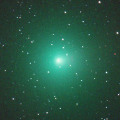
|
It brightened up to 7.3 mag in November (Nov. 7, Marco Goiato). Now it is fading. But it is bright as 9.8 mag still now (Dec. 17, Osamu Miyazaki). In the Northern Hemisphere, it stays observable in excellent condition for a long time. In the Southern Hemisphere, it stays locating extremely low after this.
Date(TT) R.A. (2000) Decl. Delta r Elong. m1 Best Time(A, h)
Dec. 26 5 14.29 43 29.3 0.603 1.553 155 9.7 22:53 (180, 81)
Jan. 2 5 13.93 45 43.9 0.684 1.612 150 10.2 22:25 (180, 79)
|
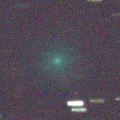
|
It brightened very rapidly in early December. Now it is very bright as 11.8 mag (Dec. 14, Alan Hale). In addition, Michael Jager observed two more components of 16.5-17.5 mag. It stays observable for a long time in this apparition.
Date(TT) R.A. (2000) Decl. Delta r Elong. m1 Best Time(A, h)
Dec. 26 22 5.99 -8 42.7 0.659 0.823 56 11.2 18:25 ( 48, 33)
Jan. 2 22 50.96 -8 12.3 0.601 0.853 59 11.1 18:30 ( 46, 35)
|
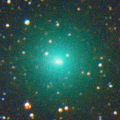
|
It brightened up to 8.2 mag in autumn (Oct. 13, Chris Wyatt). Now it is fading. But it is bright as 10.7 mag still now (Dec. 14, Seiichi Yoshida). It stays observable in the evening low sky while it will be getting fainter gradually, until early January in the Southern Hemisphere, or late February in the Northern Hemisphere.
Date(TT) R.A. (2000) Decl. Delta r Elong. m1 Best Time(A, h)
Dec. 26 21 57.91 -15 44.1 2.082 1.664 51 11.2 18:25 ( 45, 26)
Jan. 2 22 17.46 -13 48.1 2.166 1.706 49 11.5 18:30 ( 49, 25)
|
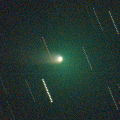
|
Brightened rapidly. Now it is very bright as 10.3 mag (Dec. 15, Carlos Labordena). In the Northern Hemisphere, it stays observable in good condition for a long time. In the Southern Hemisphere, it will be extremely low after January.
Date(TT) R.A. (2000) Decl. Delta r Elong. m1 Best Time(A, h)
Dec. 26 0 56.04 23 37.4 0.754 1.404 107 11.6 18:36 ( 0, 79)
Jan. 2 1 13.92 26 52.5 0.815 1.431 105 12.0 18:30 ( 5, 82)
|

|
Now it is bright as 11.9 mag (Dec. 3, Ken-ichi Kadota). It stays 12 mag until March. In the Southern Hemisphere, it stays observable in good condition after this. In the Northern Hemisphere, it will be observable in the extremely low sky only from November to December.
Date(TT) R.A. (2000) Decl. Delta r Elong. m1 Best Time(A, h)
Dec. 26 14 23.54 -37 50.6 2.160 1.734 51 11.7 5:35 (331, 9)
Jan. 2 14 31.42 -42 59.3 2.095 1.753 56 11.7 5:37 (337, 7)
|
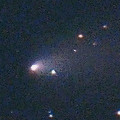
|
First return of a new periodic comet which brightened up to 13 mag in 2009. Now it is bright as 12.4 mag (Dec. 14, Seiichi Yoshida). It stays 12 mag until January, and it is observable in excellent condition.
Date(TT) R.A. (2000) Decl. Delta r Elong. m1 Best Time(A, h)
Dec. 26 4 39.32 -3 33.9 0.376 1.306 143 12.2 22:18 ( 0, 52)
Jan. 2 4 47.08 0 26.0 0.382 1.308 142 12.2 21:59 ( 0, 56)
|
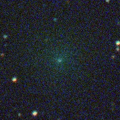
|
Brightened rapidly. Now it is very bright as 12.3 mag (Dec. 21, Ken-ichi Kadota). It will approach to Earth down to 0.46 a.u. in April, and it is expected to brighten up to 9 mag and to be observable in excellent condition. It will be unobservable temporarily from January to February.
Date(TT) R.A. (2000) Decl. Delta r Elong. m1 Best Time(A, h)
Dec. 26 21 21.89 -19 34.5 2.053 1.485 42 12.8 18:25 ( 50, 17)
Jan. 2 21 16.14 -18 51.0 2.109 1.409 34 12.6 18:30 ( 57, 11)
|
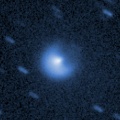
|
Now it is 13.1 mag (Dec. 13, Toshihiko Ikemura, Hirohisa Sato).
Date(TT) R.A. (2000) Decl. Delta r Elong. m1 Best Time(A, h)
Dec. 26 2 14.88 24 36.0 5.230 5.846 124 13.3 19:54 ( 0, 80)
Jan. 2 2 14.55 24 21.8 5.327 5.847 117 13.4 19:26 ( 0, 79)
|
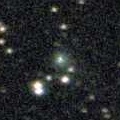
|
Now it is 13.2 mag (Dec. 12, Toshihiko Ikemura, Hirohisa Sato). It will brighten up to 11 mag in winter in 2022. In the Northern Hemisphere, it stays observable in good condition for a long time. In the Southern Hemisphere, it is not observable until 2021 November.
Date(TT) R.A. (2000) Decl. Delta r Elong. m1 Best Time(A, h)
Dec. 26 0 6.24 57 44.9 4.496 4.890 107 14.0 18:25 (167, 66)
Jan. 2 0 11.90 56 51.8 4.516 4.849 104 14.0 18:30 (158, 65)
|
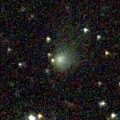
|
Now it is 13.8 mag (Dec. 22, Toshihiko Ikemura, Hirohisa Sato). It is expected to be observable at 5-6 mag for a long time from 2022 to 2023. In the Northern Hemisphere, it is not observable at the high light from 2022 summer to 2023 summer. In the Southern Hemisphere, it is not observable now. But it will be observable in good condition at the high light.
Date(TT) R.A. (2000) Decl. Delta r Elong. m1 Best Time(A, h)
Dec. 26 17 49.00 35 14.5 7.943 7.485 59 14.2 5:35 (241, 20)
Jan. 2 17 53.33 35 6.1 7.880 7.431 59 14.2 5:37 (243, 25)
|
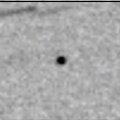
|
It will brighten up to 11.5 mag in spring. However, the condition is very bad in this apparition. It will appear in the morning low sky in March in the Southern Hemisphere, or in June in the Northern Hemisphere.
Date(TT) R.A. (2000) Decl. Delta r Elong. m1 Best Time(A, h)
Dec. 26 17 32.42 -18 13.1 2.629 1.680 12 14.6 5:35 (288, -6)
Jan. 2 17 53.55 -18 45.7 2.582 1.644 13 14.2 5:37 (290, -5)
|
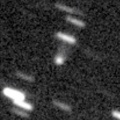
|
Now it is 14.8 mag (May 14, Toshiyuki Takahashi). It will brighten up to 13 mag from spring to summer. In the Southern Hemisphere, it stays observable in good condition for a long time. In the Northern Hemisphere, it is not observable until July in 2022.
Date(TT) R.A. (2000) Decl. Delta r Elong. m1 Best Time(A, h)
Dec. 26 16 10.29 -45 23.4 4.716 3.941 34 14.3 5:35 (320, -9)
Jan. 2 16 21.01 -46 44.1 4.641 3.916 38 14.3 5:37 (324, -8)
|
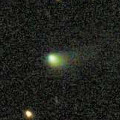
|
It stays 13-14 mag from 2020 to 2021. Appearing in the moring sky. It will be observable in good condition after this in the Southern Hemisphere. It locates somewhat low in the Northern Hemisphere.
Date(TT) R.A. (2000) Decl. Delta r Elong. m1 Best Time(A, h)
Dec. 26 16 36.57 -18 25.4 3.748 2.882 24 14.3 5:35 (296, 4)
Jan. 2 16 48.42 -19 5.4 3.702 2.878 28 14.3 5:37 (299, 7)
|

|
It had been observed as 8-9 mag for a long time in 2020. Now it is not observable. It will appear in the morning sky at 14.5 mag.
Date(TT) R.A. (2000) Decl. Delta r Elong. m1 Best Time(A, h)
Dec. 26 16 44.93 -25 25.4 4.221 3.326 21 14.3 5:35 (300, -2)
Jan. 2 16 52.82 -26 25.9 4.241 3.392 26 14.4 5:37 (304, 2)
|
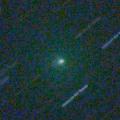
|
It brightened very rapidly up to 12.5 mag in early December (Dec. 7, Michael Jager). Now it is fading. It has already faded down to 15.9 mag (Dec. 21, Toshihiko Ikemura, Hirohisa Sato). It stays observable in excellent condition for a while.
Date(TT) R.A. (2000) Decl. Delta r Elong. m1 Best Time(A, h)
Dec. 26 1 59.93 6 45.5 0.691 1.427 115 14.6 19:40 ( 0, 62)
Jan. 2 2 19.22 6 18.3 0.745 1.447 112 15.0 19:32 ( 0, 61)
|
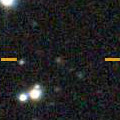
|
Now it is 15.8 mag (Dec. 3, Ken-ichi Kadota). It will brighten up to 13.5 mag from winter to spring. In the Northern Hemisphere, it stays observable in excellent condition. In the Southern Hemisphere, it stays extremely low until spring.
Date(TT) R.A. (2000) Decl. Delta r Elong. m1 Best Time(A, h)
Dec. 26 23 59.56 34 56.6 1.268 1.727 99 14.9 18:25 ( 93, 81)
Jan. 2 0 13.92 33 16.3 1.256 1.665 95 14.7 18:30 ( 87, 77)
|

|
Tiny comet of Kreutz group. It was visible at 5 mag on the ground at the total eclipse on Dec. 14. It is observable in the Southern Hemisphere. But it must have already disappeared.
Date(TT) R.A. (2000) Decl. Delta r Elong. m1 Best Time(A, h)
Dec. 26 16 53.25 -49 18.8 0.652 0.541 30 14.9 5:35 (318,-17)
Jan. 2 16 53.41 -69 21.5 0.567 0.752 49 16.0 5:37 (338,-25)
|

|
Now it is 14.9 mag (Oct. 10, Chris Wyatt). It will brighten up to 13.5 mag in spring. In the Southern Hemisphere, it stays observable in good condition for a long time, although it became unobservable temporarily in December. In the Northern Hemisphere, it is not observable until spring.
Date(TT) R.A. (2000) Decl. Delta r Elong. m1 Best Time(A, h)
Dec. 26 17 38.49 -42 50.6 4.418 3.519 21 15.2 5:35 (309,-21)
Jan. 2 17 41.60 -42 24.0 4.375 3.500 24 15.1 5:37 (311,-16)
|
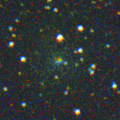
|
Now it is 15.8 mag (Nov. 5, Ken-ichi Kadota). It will be unobservable soon.
Date(TT) R.A. (2000) Decl. Delta r Elong. m1 Best Time(A, h)
Dec. 26 20 59.70 -16 19.6 2.808 2.125 38 15.2 18:25 ( 56, 16)
Jan. 2 21 13.79 -14 38.8 2.845 2.115 34 15.2 18:30 ( 61, 14)
|
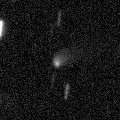
|
Now it is 15.0 mag (Nov. 15, Chris Wyatt). It stays 14-15 mag until 2021. In the Southern Hemisphere, it stays observable in good condition for a long time. In the Northern Hemisphere, it is not observable until June.
Date(TT) R.A. (2000) Decl. Delta r Elong. m1 Best Time(A, h)
Dec. 26 20 31.09 -57 15.3 5.076 4.387 41 15.2 18:25 ( 30,-16)
Jan. 2 20 44.13 -55 56.5 5.097 4.378 39 15.2 18:30 ( 33,-18)
|
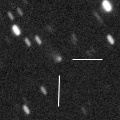
|
Now it is 15.9 mag (Nov. 10, Toshihiko Ikemura, Hirohisa Sato). It will stay at 14 mag for a long time from 2021 to 2022. In the Northern Hemisphere, it stays observable in good condition while brightening gradually, although it became unobservable temporarily in December. In the Southern Hemisphere, it is not observable until February.
Date(TT) R.A. (2000) Decl. Delta r Elong. m1 Best Time(A, h)
Dec. 26 17 57.76 5 29.7 6.368 5.532 29 15.4 5:35 (265, 2)
Jan. 2 18 1.19 4 58.9 6.335 5.509 30 15.4 5:37 (269, 7)
|

|
Now it is 14.5 mag (Dec. 21, Toshihiko Ikemura, Hirohisa Sato). In the Northern Hemisphere, it stays observable for a long time while it is getting fainter slowly. In the Southern Hemisphere, it will never be observable again.
Date(TT) R.A. (2000) Decl. Delta r Elong. m1 Best Time(A, h)
Dec. 26 16 17.98 59 50.6 4.882 4.926 86 15.5 5:35 (218, 42)
Jan. 2 16 23.52 60 5.8 4.904 4.973 88 15.5 5:37 (217, 45)
|
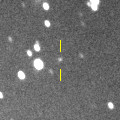
|
Now it is 15.4 mag (Dec. 3, Ken-ichi Kadota). It is expected to brighten up to 13 mag in 2022. It is observable in excellent condition in the Southern Hemisphere. In the Northern Hemisphere, it is observable from autumn to winter, but it locating extremely low.
Date(TT) R.A. (2000) Decl. Delta r Elong. m1 Best Time(A, h)
Dec. 26 8 28.67 -39 58.6 5.610 6.015 109 15.5 2:10 ( 0, 15)
Jan. 2 8 26.23 -40 20.1 5.526 5.978 112 15.5 1:40 ( 0, 15)
|
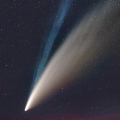
|
It approached to Sun down to 0.29 a.u. on July 3, and it brightened up to 0.6 mag (Alan Hale). Now it is fading. It has been already fainter than 15.0 mag (Oct. 12, Mitsunori Tsumura). Appearing in the morning sky.
Date(TT) R.A. (2000) Decl. Delta r Elong. m1 Best Time(A, h)
Dec. 26 16 23.29 -22 44.8 4.023 3.175 26 15.5 5:35 (301, 4)
Jan. 2 16 27.61 -23 15.4 4.049 3.265 32 15.7 5:37 (306, 8)
|

|
It approached to Sun down to 0.14 a.u. on Dec. 7, and it must have brightened up to 11 mag. But it was not observable at the high light. In the Northern Hemisphere, it is observable in the evening low sky from January to February. It is not observable in the Southern Hemisphere.
Date(TT) R.A. (2000) Decl. Delta r Elong. m1 Best Time(A, h)
Dec. 26 20 7.02 -9 10.3 1.216 0.603 29 15.6 18:25 ( 70, 12)
Jan. 2 20 54.05 -4 25.3 1.301 0.754 35 16.1 18:30 ( 72, 17)
|
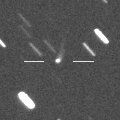
|
Now it is 16.3 mag (Nov. 9, Toshihiko Ikemura, Hirohisa Sato). It will brighten up to 14.5 mag from spring to summer. In the Southern Hemisphere, it stays observable in excellent condition for a long time. In the Northern Hemisphere, it is not observable after this.
Date(TT) R.A. (2000) Decl. Delta r Elong. m1 Best Time(A, h)
Dec. 26 21 27.07 -33 54.2 3.570 2.917 42 15.9 18:25 ( 40, 7)
Jan. 2 21 32.17 -34 32.2 3.610 2.888 37 15.9 18:30 ( 43, 3)
|
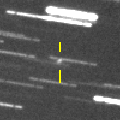
|
First return of a new periodic comet which brightened up to 17 mag in 2013. Now it is 16.6 mag (Dec. 12, Toshihiko Ikemura, Hirohisa Sato). It stays 16 mag until January.
Date(TT) R.A. (2000) Decl. Delta r Elong. m1 Best Time(A, h)
Dec. 26 12 33.22 19 5.9 0.470 1.122 94 15.9 5:35 (329, 72)
Jan. 2 12 54.68 14 57.9 0.477 1.128 94 15.9 5:37 (339, 69)
|
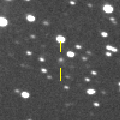
|
It brightened rapidly and became brighter than expected. Now it is 15.8 mag (Dec. 21, Toshihiko Ikemura, Hirohisa Sato). It is observable in good condition in the Northern Hemisphere. It locates somewhat low in the Southern Hemisphere.
Date(TT) R.A. (2000) Decl. Delta r Elong. m1 Best Time(A, h)
Dec. 26 2 28.06 29 18.1 1.131 1.905 128 16.1 20:08 ( 0, 84)
Jan. 2 2 35.72 27 48.0 1.182 1.905 122 16.1 19:48 ( 0, 83)
|
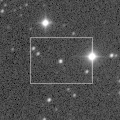
|
Now it is 15.7 mag (Dec. 8, Toshihiko Ikemura, Hirohisa Sato). It stays 15-16 mag until winter. In the Northern Hemisphere, it stays observable in good condition for a long time after this. In the Southern Hemisphere, it will be unobservable in January.
Date(TT) R.A. (2000) Decl. Delta r Elong. m1 Best Time(A, h)
Dec. 26 23 26.29 4 2.8 1.056 1.306 79 16.2 18:25 ( 35, 54)
Jan. 2 23 42.95 8 58.3 1.103 1.321 78 16.3 18:30 ( 46, 57)
|

|
First return of a new periodic comet which brightened up to 14-15 mag in 2006. Now it is 17.1 mag (Dec. 19, Toshihiko Ikemura, Hirohisa Sato). It will brighten up to 15-16 mag from February to March, and will be observable in good condition.
Date(TT) R.A. (2000) Decl. Delta r Elong. m1 Best Time(A, h)
Dec. 26 11 33.90 1 30.8 1.321 1.791 100 16.6 5:15 ( 0, 56)
Jan. 2 11 48.44 1 35.5 1.250 1.777 104 16.4 5:02 ( 0, 56)
|
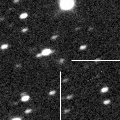
|
Now it is 16.4 mag (Dec. 17, Toshihiko Ikemura, Hirohisa Sato). It is observable at 16.5-17 mag from 2020 to 2021. In the Southern Hemisphere, it is not observable until summer in 2021
Date(TT) R.A. (2000) Decl. Delta r Elong. m1 Best Time(A, h)
Dec. 26 22 10.69 51 4.7 5.881 5.965 90 16.6 18:25 (132, 58)
Jan. 2 22 13.87 49 42.9 5.957 5.961 85 16.6 18:30 (128, 54)
|
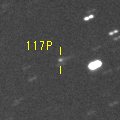
|
Now it is 17.2 mag (Dec. 20, Toshihiko Ikemura, Hirohisa Sato). It will brighten up to 13 mag in 2022. In 2021, it is observable at 15-16 mag in good condition.
Date(TT) R.A. (2000) Decl. Delta r Elong. m1 Best Time(A, h)
Dec. 26 13 24.04 -1 36.5 4.071 3.924 74 16.7 5:35 (325, 48)
Jan. 2 13 28.88 -1 59.4 3.952 3.908 80 16.6 5:37 (334, 50)
|
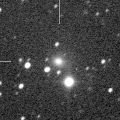
|
It brightened up to 13.5 mag in last winter (Dec. 6, 2019, Chris Wyatt). Now it is fading slowly. Now it is 17.1 mag (Dec. 19, Toshihiko Ikemura, Hirohisa Sato). In the Southern Hemisphere, it stays observable for a long time. It locates somewhat low in the Northern Hemisphere. Taras Prystavski found its fragmentation on Sept. 12.
Date(TT) R.A. (2000) Decl. Delta r Elong. m1 Best Time(A, h)
Dec. 26 1 14.58 -25 52.6 4.764 4.889 91 16.7 18:54 ( 0, 29)
Jan. 2 1 13.40 -24 24.1 4.907 4.931 85 16.8 18:30 ( 1, 31)
|
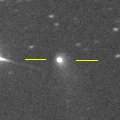
|
It brightened up to 13.8 mag in autumn in 2019 (Sept. 3, 2019, Chris Wyatt). Now it is fading slowly. It has already faded down to 17.2 mag (Dec. 8, Toshihiko Ikemura, Hirohisa Sato).
Date(TT) R.A. (2000) Decl. Delta r Elong. m1 Best Time(A, h)
Dec. 26 23 43.66 4 2.8 6.916 6.874 83 16.7 18:25 ( 29, 56)
Jan. 2 23 44.94 4 26.5 7.074 6.917 76 16.8 18:30 ( 41, 53)
|
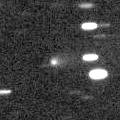
|
Now it is 16.9 mag (Dec. 10, Toshihiko Ikemura, Hirohisa Sato). It stays 16 mag until winter, and observable in good condition. It locates somewhat low in the Southern Hemisphere.
Date(TT) R.A. (2000) Decl. Delta r Elong. m1 Best Time(A, h)
Dec. 26 8 34.89 19 56.1 1.587 2.479 148 16.8 2:17 ( 0, 75)
Jan. 2 8 29.36 20 40.1 1.583 2.517 156 16.9 1:44 ( 0, 76)
|
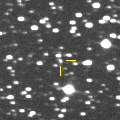
|
Now it is 16.6 mag (Nov. 9, Toshihiko Ikemura, Hirohisa Sato). It stays at 16-17 mag from 2020 to 2021. In the Northern Hemisphere, it stays observable in good condition for a long time. It is not observable in the Southern Hemisphere.
Date(TT) R.A. (2000) Decl. Delta r Elong. m1 Best Time(A, h)
Dec. 26 19 14.12 29 53.1 9.359 8.829 54 16.8 18:25 (112, 22)
Jan. 2 19 17.08 30 10.9 9.377 8.828 53 16.8 18:30 (116, 17)
|
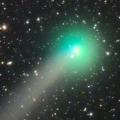
|
It brightened up to 6.0 mag in June (June 13, Marco Goiato). Now it is fading. It has already faded down to 15.5 mag (Nov. 18, Thomas Lehmann). In the Northern Hemisphere, it stays observable for a long time until it fades out. In the Southern Hemisphere, it will never be observable again.
Date(TT) R.A. (2000) Decl. Delta r Elong. m1 Best Time(A, h)
Dec. 26 19 17.51 26 3.3 3.498 2.985 51 16.9 18:25 (108, 21)
Jan. 2 19 29.59 26 45.1 3.596 3.067 50 17.1 18:30 (111, 17)
|
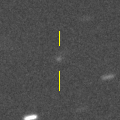
|
Now it is 16.6 mag (Dec. 22, Toshihiko Ikemura, Hirohisa Sato). It is expected to brighten up to 14 mag from spring to summer, and it stays observable in good condition for a long time.
Date(TT) R.A. (2000) Decl. Delta r Elong. m1 Best Time(A, h)
Dec. 26 13 2.48 25 18.9 2.880 3.056 90 17.1 5:35 (299, 72)
Jan. 2 13 11.57 25 31.0 2.748 3.001 95 17.0 5:37 (310, 76)
|
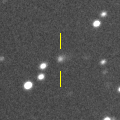
|
It brightened up to 16.1 mag in last winter (Mar. 18, Toshihiko Ikemura, Hirohisa Sato). Now it is 17.7 mag (Dec. 21, Toshihiko Ikemura, Hirohisa Sato). In 2021, it stays observable at 17 mag in good condition until summer.
Date(TT) R.A. (2000) Decl. Delta r Elong. m1 Best Time(A, h)
Dec. 26 13 4.23 -20 4.6 6.998 6.764 72 17.0 5:35 (340, 32)
Jan. 2 13 7.04 -20 14.5 6.901 6.775 78 17.0 5:37 (348, 34)
|
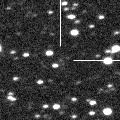
|
Now it is 17.3 mag (Dec. 19, Toshihiko Ikemura, Hirohisa Sato). It stays 15-16 mag for a long time from 2021 spring to 2022 spring. It stays observable for a long time in the Northern Hemisphere. In the Southern Hemipsphere, it is not observable until the end of 2021.
Date(TT) R.A. (2000) Decl. Delta r Elong. m1 Best Time(A, h)
Dec. 26 19 35.90 43 34.5 4.019 3.784 69 17.2 18:25 (124, 32)
Jan. 2 19 39.53 43 42.7 4.007 3.744 67 17.1 18:30 (126, 27)
|
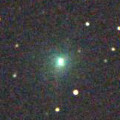
|
It approached to Sun down to 0.34 a.u. on Oct. 20. Then the nucleus was disintegrated. After the perihelion passage, it was observed at 12.5 mag (Oct. 28, Michael Jager). Now only the remnant tail is visible. In the Northern Hemisphere, it stays observable while the comet will be fading rapidly. In the Southern Hemipshere, it will never be observable again.
Date(TT) R.A. (2000) Decl. Delta r Elong. m1 Best Time(A, h)
Dec. 26 15 30.17 5 52.2 1.967 1.542 50 17.3 5:35 (287, 32)
Jan. 2 15 37.20 5 46.0 2.014 1.661 55 17.7 5:37 (292, 37)
|

|
It stays observable at 16-17 mag from 2021 to 2022.
Date(TT) R.A. (2000) Decl. Delta r Elong. m1 Best Time(A, h)
Dec. 26 14 11.45 -27 50.9 5.686 5.191 55 17.4 5:35 (328, 19)
Jan. 2 14 15.61 -27 40.4 5.566 5.169 61 17.4 5:37 (333, 22)
|
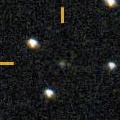
|
Now it is 17.0 mag (Dec. 9, Toshihiko Ikemura, Hirohisa Sato). It is observable at 17-18 mag for a long time from late 2019 to early 2021. It will fade out before it passes the perihelion.
Date(TT) R.A. (2000) Decl. Delta r Elong. m1 Best Time(A, h)
Dec. 26 5 35.98 18 7.2 3.505 4.473 168 17.4 23:14 ( 0, 73)
Jan. 2 5 31.85 18 23.4 3.522 4.464 161 17.5 22:43 ( 0, 73)
|
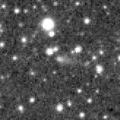
|
First return of a new periodic comet which brightened up to 17.5 mag in 2012. Now it is 17.9 mag (Dec. 9, Toshihiko Ikemura, Hirohisa Sato). It stays observable at 17 mag in good condition from summer to winter. It locates low in the Southern Hemisphere.
Date(TT) R.A. (2000) Decl. Delta r Elong. m1 Best Time(A, h)
Dec. 26 4 33.01 38 11.9 1.723 2.637 152 17.5 22:12 (180, 87)
Jan. 2 4 28.97 37 46.8 1.785 2.660 146 17.6 21:40 (180, 87)
|

|
Now it is 17.9 mag (Nov. 19, Giuseppe Pappa). It is expected to brighten up to 12 mag in 2022. In the Southern Hemisphere, it stays observable in good condition for a long time. In the Northern Hemisphere, it is not observable until 2022.
Date(TT) R.A. (2000) Decl. Delta r Elong. m1 Best Time(A, h)
Dec. 26 3 9.11 -50 10.5 6.255 6.421 95 17.6 20:47 ( 0, 5)
Jan. 2 3 2.83 -49 50.8 6.269 6.372 91 17.5 20:13 ( 0, 5)
|
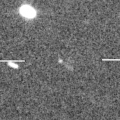
|
Now it is 18.2 mag (Nov. 23, Toshihiko Ikemura, Hirohisa Sato). It is expected to brighten up to 10 mag in 2023. In the Northern Hemisphere, it stays observable in good condition until 2023 autumn. In the Southern Hemipshere, it stays hardly observable for a while. But it becomes observable in good condition after 2023 summer.
Date(TT) R.A. (2000) Decl. Delta r Elong. m1 Best Time(A, h)
Dec. 26 13 19.41 26 19.6 8.301 8.322 87 17.8 5:35 (290, 70)
Jan. 2 13 20.07 26 55.4 8.144 8.271 93 17.7 5:37 (300, 75)
|
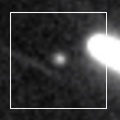
|
Now it is 17.7 mag (Nov. 3, ATLAS-HKO, Haleakala). Although it is an asteroid, it is brightening rapidly. It may brighten up to 11 mag in 2023.
Date(TT) R.A. (2000) Decl. Delta r Elong. m1 Best Time(A, h)
Dec. 26 18 15.61 36 42.5 8.127 7.684 60 17.8 5:35 (236, 16)
Jan. 2 18 18.44 36 44.5 8.081 7.640 60 17.8 5:37 (239, 21)
|

|
Five apparitions of this comet was confirmed in 1999, 2004, 2008, 2012 and 2016. It will approach to Sun down to 0.04 a.u. on Jan. 17. It may be observed on the ground in December and February.
Date(TT) R.A. (2000) Decl. Delta r Elong. m1 Best Time(A, h)
Dec. 26 14 50.06 -17 33.1 0.993 0.821 49 19.1 5:35 (314, 23)
Jan. 2 15 58.11 -21 43.9 0.893 0.642 39 17.8 5:37 (310, 14)
|
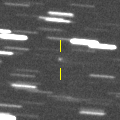
|
Now it is 17.3 mag (Dec. 12, Toshihiko Ikemura, Hirohisa Sato). It stays observable at 17-18 mag in good condition until winter.
Date(TT) R.A. (2000) Decl. Delta r Elong. m1 Best Time(A, h)
Dec. 26 7 43.78 22 16.1 1.368 2.318 160 17.8 1:26 ( 0, 77)
Jan. 2 7 37.59 23 13.4 1.377 2.350 169 17.9 0:53 ( 0, 78)
|
|
![]()
 C/2020 J1 ( SONEAR )
C/2020 J1 ( SONEAR ) 17P/Holmes
17P/Holmes C/2020 F5 ( MASTER )
C/2020 F5 ( MASTER ) C/2018 U1 ( Lemmon )
C/2018 U1 ( Lemmon ) C/2018 N2 ( ASASSN )
C/2018 N2 ( ASASSN ) C/2019 T4 ( ATLAS )
C/2019 T4 ( ATLAS ) C/2020 F3 ( NEOWISE )
C/2020 F3 ( NEOWISE ) (3200) Phaethon
(3200) Phaethon C/2019 T2 ( Lemmon )
C/2019 T2 ( Lemmon ) 405P/2020 U1 ( Lemmon )
405P/2020 U1 ( Lemmon ) 277P/LINEAR
277P/LINEAR 162P/Siding Spring
162P/Siding Spring 409P/2020 V1 ( LONEOS-Hill )
409P/2020 V1 ( LONEOS-Hill ) C/2019 T3 ( ATLAS )
C/2019 T3 ( ATLAS ) 117P/Helin-Roman-Alu 1
117P/Helin-Roman-Alu 1 C/2018 F4 ( PanSTARRS )
C/2018 F4 ( PanSTARRS ) C/2017 B3 ( LINEAR )
C/2017 B3 ( LINEAR ) 84P/Giclas
84P/Giclas C/2019 O3 ( Palomar )
C/2019 O3 ( Palomar ) C/2019 U6 ( Lemmon )
C/2019 U6 ( Lemmon ) C/2020 T2 ( Palomar )
C/2020 T2 ( Palomar ) C/2019 C1 ( ATLAS )
C/2019 C1 ( ATLAS ) C/2020 M5 ( ATLAS )
C/2020 M5 ( ATLAS ) C/2020 P1 ( NEOWISE )
C/2020 P1 ( NEOWISE ) C/2020 H6 ( ATLAS )
C/2020 H6 ( ATLAS ) 173P/Mueller 5
173P/Mueller 5 397P/2020 M2 ( Lemmon )
397P/2020 M2 ( Lemmon ) C/2020 R7 ( ATLAS )
C/2020 R7 ( ATLAS ) C/2020 V2 ( ZTF )
C/2020 V2 ( ZTF ) A/2019 U5
A/2019 U5 323P/SOHO
323P/SOHO 178P/Hug-Bell
178P/Hug-Bell![]()










































